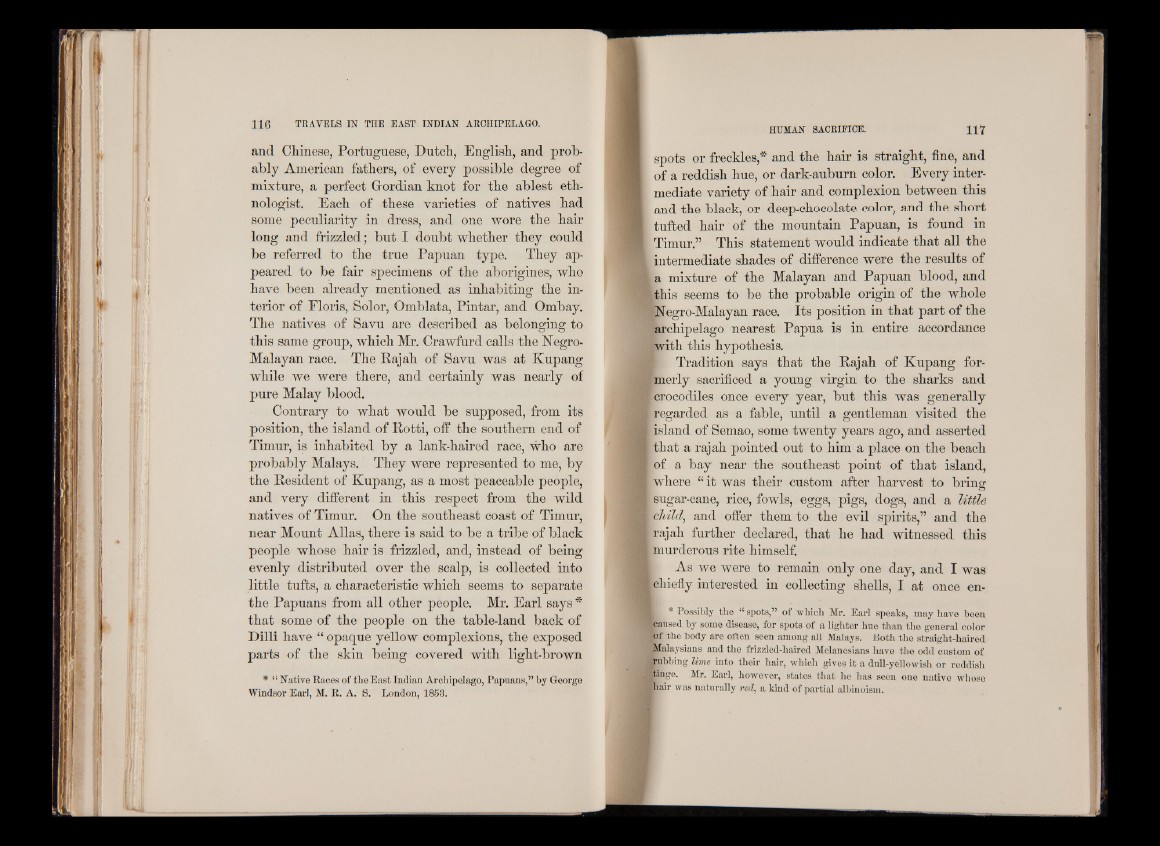
and Chinese, Portuguese, Dutch, English, and probably
American fathers, of every possible degree of
mixture, a perfect Grordian knot for the ablest ethnologist.
Each of these varieties of natives had
some peculiarity in dress, and one wore the hair
long and frizzled; but I doubt whether they could
be referred to the true Papuan type. They appeared
to be fair specimens of the aborigines, who
have been already mentioned as inhabiting the interior
of Floris, Solor, Omblata, Pintar, and Ombay.
The natives of Savu are described as belonging to
this same group, which Mr. Crawfurd calls the Negro-
Malayan race. The Rajah of Savu was at Kupang
while we were there, and certainly was nearly of
pure Malay blood.
Contrary to what would be supposed, from its
position, the island of Rotti, off the southern end of
Timur, is inhabited by a lank-haired race, who are
probably Malays. They were represented to me, by
the Resident of Kupang, as a most peaceable people,
and very different in this respect from the wild
natives of Timur. On the southeast coast of Timur,
near Mount Allas, there is said to be a tribe of black
people whose hair is frizzled, and, instead of being
evenly distributed over the scalp, is collected into
little tufts, a characteristic which seems to separate
the Papuans from all other people. Mr. Earl says *
that some of the people on the table-land back of
Dilli have “ opaque yellow complexions, the exposed
parts of the skin being covered with light-brown
* “ Native Races of the East Indian Archipelago, Papuans,” by George
Windsor Earl, M. R. A. S. London, 1858.
spots or freckles,* and the hair is straight, fine, and
of a reddish hue, or dark-auburn color. Every intermediate
variety of hair and complexion between this
and the black, or deep-chocolate color, and the short
tufted hair of the mountain Papuan, is found in
Timur.” This statement would indicate that all the
intermediate shades of difference were the results of
a mixture of the Malayan and Papuan blood, and
Ithis seems to be the probable origin of the whole
Kegro-Malayan race. Its position in that part of the
archipelago nearest Papua is in entire accordance
with this hypothesis.
Tradition says that the Rajah of Kupang for-
[merly sacrificed a young virgin to the sharks and
[crocodiles once every year, but this was generally
regarded as a fable, until a gentleman visited the
[island of Semao, some twenty years ago, and asserted
that a rajah pointed out to him a place on the beach
of a bay near the southeast point of that island,
[where “ it was their custom after harvest to bring
sugar-cane, rice, fowls, eggs, pigs, dogs, and a little
| child, and offer them to the evil spirits,” and the
rajah further declared, that he had witnessed this
; murderous rite himself.
As we were to remain only one day, and I was
[chiefly interested in collecting shells, I at once en-
I * Possibly tbe “ spots,” of which Mr. Earl speaks, may have been
Icaused by some disease, for spots of a lighter hue than the general color
of the body are often seen among all Malays. Both the straight-haired
Malaysians and the frizzled-haired Melanesians have the odd custom of
¡rubbing lime into their hair, which gives it a dull-yellowish or reddish
¡tinge. Mr. Earl, however, states that he has seen one native whose
hair was naturally red, a kind of partial albinoism.